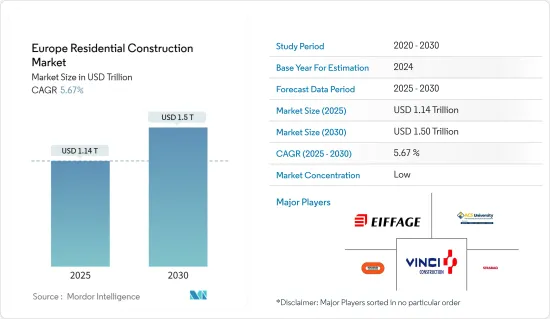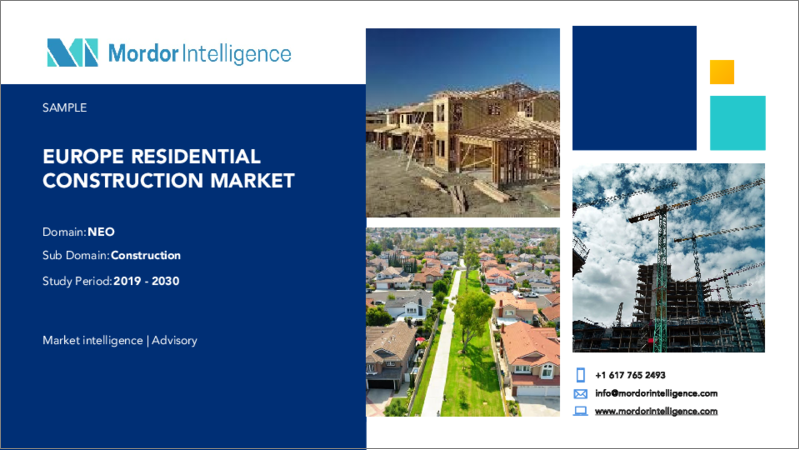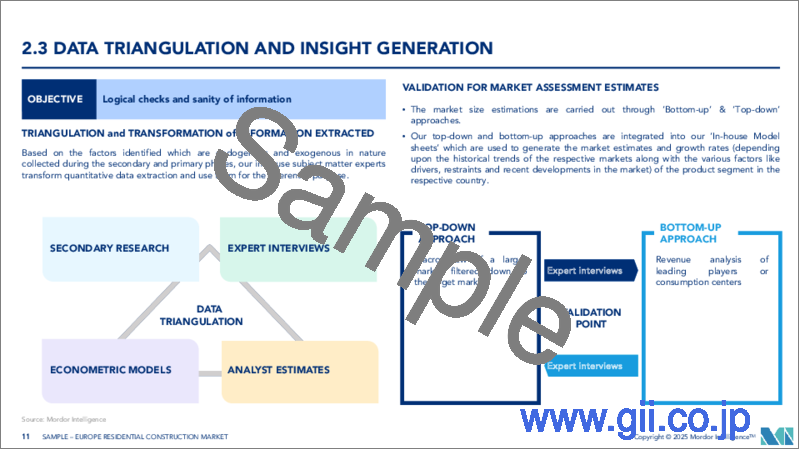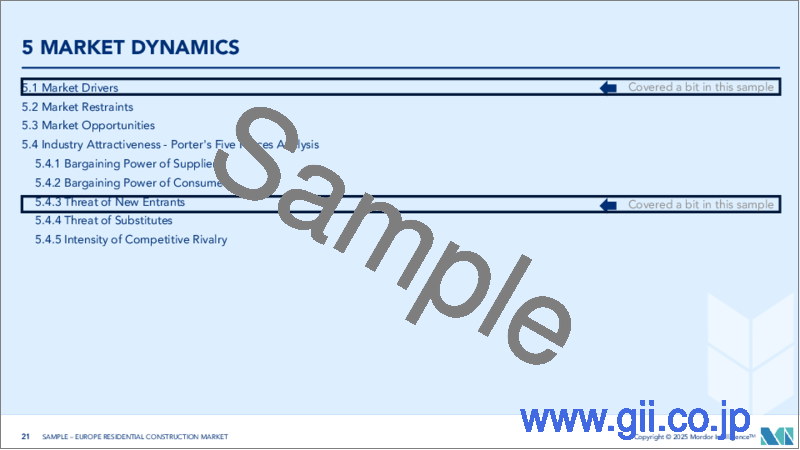|
|
市場調査レポート
商品コード
1644957
欧州の住宅建設:市場シェア分析、産業動向・統計、成長予測(2025~2030年)Europe Residential Construction - Market Share Analysis, Industry Trends & Statistics, Growth Forecasts (2025 - 2030) |
||||||
カスタマイズ可能
適宜更新あり
|
|||||||
| 欧州の住宅建設:市場シェア分析、産業動向・統計、成長予測(2025~2030年) |
|
出版日: 2025年01月05日
発行: Mordor Intelligence
ページ情報: 英文 150 Pages
納期: 2~3営業日
|
全表示
- 概要
- 目次
欧州の住宅建設の市場規模は2025年に1兆1,400億米ドルと推定され、予測期間中(2025-2030年)のCAGRは5.67%で、2030年には1兆5,000億米ドルに達すると予測されます。

主なハイライト
- 欧州委員会は、今後10年間、すなわち2050年までに改築率を少なくとも2倍にするという野心的な目標を発表しました。欧州委員会は、こうした改築はエネルギー効率と資源効率を優先すべきであると強調しています。こうした対策は、居住者の生活の質を高め、欧州全域の温室効果ガス排出を抑制し、デジタル化を促進し、材料の再利用とリサイクルを促進することが期待されています。
- 欧州中央銀行は経済成長を促進するために金利を引き下げました。この措置により、建設会社の資金調達条件が緩和され、住宅プロジェクト向けの融資がより容易かつ費用対効果の高いものとなった。金利引き下げは建設部門にポジティブなシグナルを送り、投資家の信頼感を高め、住宅建設市場の回復に対する楽観的な見方を醸成しました。特筆すべきは、この決定が、不透明な経済情勢の中、借入コストの上昇に悩む開発業者に大きな救いを与えたことです。
- EUの新しい建築規制を強化し、加盟国の行動を導くための新たな基準として、建築部門での再生可能エネルギー使用率49%という目標が導入されました。さらに、新たに設立された社会的気候基金は、860億ユーロ(約910億米ドル)を超える配分で、これらの対象となる社会的弱者のためのさまざまな構造的対策や投資に資金を提供することを目的としています。これらの対策には、建物の改修(断熱改修など)も含まれます。
- 南欧では記録的な猛暑により建設プロジェクトが中断され、大幅な遅れにつながったほか、労働者の安全に対する懸念も高まり、屋外での作業はより危険なものとなった。このような出来事は、気候変動によって建設業界が直面している課題が深刻化していることを浮き彫りにし、異常気象への備えと安全対策の強化が急務であることを強調しています。さらに、熱波は、気候条件の予測不可能性が増す中、建設慣行を適応させる必要性を浮き彫りにしました。
- 建築情報モデリング(BIM)やその他の最先端技術は、欧州の住宅建設市場において、建設作業の効率性を高めるために頻繁に使用されています。拡張現実や仮想現実を建物情報モデリングと統合することで、建設プロジェクトの管理・遂行が容易になり、作業員の安全性も向上します。これは予測期間を通じて市場の成長にプラスの影響を与えると予想されます。しかし、より多くの建築資材が必要となるため、全体的な建設コストが上昇し、予測期間中の住宅建設市場の成長を妨げると予測されます。
欧州の住宅建設市場の動向
ドイツの住宅建設:課題を克服するレジリエンス
ドイツの住宅建設は課題を克服しつつあるが、適応の兆しも見られます。11月には、49.1%の企業が受注不足を指摘し、10月の48.7%からわずかに増加しました。この動向は、厳しい市場を切り抜けようとする業界の努力を浮き彫りにしています。多くの企業は、建設コストと金利の上昇に対処するため、プロジェクト計画を見直し、より効率的な道筋を模索するために革新的な取り組みを行っています。
21.5%の企業が受注キャンセルを報告していることから、業界では柔軟性と適応性が重視されていることがわかる。しかし、建設セクターは回復力を示しており、企業は成長機会を積極的に追求し、進化する経済情勢に適応しています。特筆すべきは、11.1%の企業が財務上の課題に直面しているもの、大半の企業がこれらのハードルを乗り越える能力を示しており、厳しい時代に耐える能力を示していることです。
経営環境はマイナス54.6ポイントと厳しいが、包括的な経済情勢を考えれば、これは予想外のことではないです。ドイツの予算危機やシグナ・ホールディングの債務超過といった要因が大きく立ちはだかるが、業界の適応力は、市況が安定すれば上向く可能性を示唆しています。企業が長期的な持続可能性と回復を目指しているため、慎重な楽観論がこのセクターを覆っています。
結論として、ドイツの住宅建設セクターは大きな課題に直面しているもの、その適応力とレジリエンスは長期的な回復と成長の可能性を示しています。
建物の変革:マルチレベル・ガバナンスによる欧州の持続可能性への道
建築部門の脱炭素化を先導し、EUの気候変動に関する野望を推進しているのは、アムステルダム、ストックホルム、ナントといった欧州の都市です。欧州委員会は、最近のコミュニケーションで、EUの2040年気候目標について、温室効果ガス排出をほぼゼロにし、2050年までに気候中立を達成するという包括的目標に向けた一歩を踏み出すという大胆なビジョンを打ち出しました。このビジョンの中心は、改正された建築物のエネルギー性能指令です。この指令は、野心的なマイルストーンを設定しています。EU内のすべての新しい建物は、2030年までにゼロエミッションでなければならず、公共建築物はさらに早く、2027年までにこのベンチマークを達成しなければならないです。さらに同指令は、エネルギー効率の悪い建築物の改修を加速させることを目的に、効率基準を導入します。
異常気象やエネルギーコストの高騰といった課題に対応するため、EUは快適性、持続可能性、回復力を優先し、建築環境を見直そうとしています。非効率な建築物が生活環境を悪化させ、気候変動を悪化させる可能性があることを認識し、各都市は積極的な対策を講じています。例えば、アムステルダムは、住宅改修のために、循環型のバイオベースの断熱材に取り組んでいます。麻や木質繊維、亜麻などの素材を使うことで、エネルギー効率を高めるだけでなく、有害物質を減らして健康を優先しています。一方、ストックホルムのコルカジェン(Kollkajen)は、緑と青のインフラストラクチャーで変貌を遂げ、生物多様性を擁護し、雨水を効果的に管理するコミュニティ空間を作り出しています。
ナント市もまた、持続可能な建築の実践において大きく前進しています。同市は、バイオベースの建設ソリューションや包括的な改修サービスを提供するだけでなく、不動産所有者の教育や専門スキルの向上にも深く投資しています。このような総合的なアプローチにより、持続可能性の領域における十分な情報に基づいた意思決定が保証されます。しかし、このような野心的な目標を達成することは、一人でできることではないです。持続可能な都市景観への移行の舵取りをする上で極めて重要な役割を果たす都市が、あらゆる統治レベルにわたって協力することが必要なのです。地域のイニシアチブを擁護し、EUの資源を活用することで、より持続可能で強靭な未来への歩みを推進する上で、マルチレベル・ガバナンスの重要性が明らかになります。このことは、欧州委員会による2024年3月の報告書でも強調されています。
結論として、革新的な建築手法、厳格な効率基準、マルチレベルのガバナンスを推進する上で、欧州の各都市と欧州委員会の指令が一体となった取り組みは極めて重要であり、EUは気候変動への対応と都市の回復力強化において世界の模範を示しています。
欧州の住宅建設産業の概要
欧州の住宅建設市場は、世界プレーヤーとローカルプレーヤーが混在する断片的な市場です。市場に参入している主な企業には、Vinci Construction、Bouygues Construction、Skanska AB、Eiffage Group、Balfour Beatty、Royal Bam Group、Hochtief AG、NCC AB、ACS Hochtief、Sweco AB、Porr AG、Vonovia SEなどがあります。欧州勢の中には、新規プロジェクトの開発によって市場での存在感を積極的に高めている企業もあります。例えば、ポーランドのワルシャワでは2024年7月、Skanskaが住宅プロジェクトNU Warszawa Wolaの第2フェーズに1億2,000万PLN(約2,947万米ドル)を割り当てた。このプロジェクトは、2棟の建物からなり、合計136戸のアパートメントと7戸の商業ユニットが建設されます。
さらに、主要企業は、エンドユーザーからの需要増に対応するため、合併、買収、戦略的提携などを通じて事業を拡大しています。2024年1月、卓越したプロジェクト納入で知られるスイス有数の不動産開発会社シュタイナーAGは、子会社のシュタイナー・コンストラクションSAを、フランスを拠点とする国際的建設グループ、デマチュー・バールに売却することを決定しました。
その他の特典
- エクセル形式の市場予測(ME)シート
- 3ヶ月間のアナリスト・サポート
目次
第1章 イントロダクション
- 調査の前提条件と市場定義
- 調査範囲
第2章 調査手法
第3章 エグゼクティブサマリー
第4章 市場洞察
- 現在の市場シナリオ
- 住宅建設分野における技術革新
- 業界のバリューチェーン/サプライチェーン分析
- 欧州の住宅建設市場における政府の取り組みと規制面
- 政府と官民パートナーシップによる廉価住宅支援に関する洞察
- 建設に関連するサービス(設計・エンジニアリング、フィットアウトサービス、施設管理など)に関する洞察
- 建設と建築資材に関連するコストに関する洞察
- COVID-19が市場に与える影響
第5章 市場力学
- 市場促進要因
- 市場抑制要因/課題
- 市場機会
- 業界の魅力度-ポーターのファイブフォース分析
- 供給企業の交渉力
- 買い手/消費者の交渉力
- 新規参入業者の脅威
- 代替品の脅威
- 競争企業間の敵対関係の強さ
第6章 市場セグメンテーション
- 物件タイプ別
- 一戸建て
- 集合住宅
- 建設タイプ別
- 新築
- リノベーション
- 国別
- ドイツ
- 英国
- フランス
- イタリア
- その他欧州
第7章 競合情勢
- 企業プロファイル
- Bellway p.l.c.
- Skanska AB
- Persimmon Plc
- Barratt Developments plc
- Taylor Wimpey plc
- The Berkeley Group Holdings plc
- Redrow plc
- Crest Nicholson
- Miller Homes
- Vistry Group
- Charles Church Developments Ltd*
第8章 市場機会と今後の動向
第9章 付録
The Europe Residential Construction Market size is estimated at USD 1.14 trillion in 2025, and is expected to reach USD 1.50 trillion by 2030, at a CAGR of 5.67% during the forecast period (2025-2030).

Key Highlights
- The European Commission announced its ambitious goal: to at least double renovation rates over the next decade i.e by 2050. The Commission emphasizes that these renovations should prioritize energy and resource efficiency. Such measures are expected to elevate the quality of life for occupants, curtail greenhouse gas emissions across Europe, promote digitalization, and bolster the reuse and recycling of materials.
- The European Central Bank cut interest rates to spur economic growth. This move lightened financing conditions for construction firms, making it easier and more cost-effective to obtain loans for residential projects. The rate cuts sent a positive signal to the construction sector, bolstering investor confidence and fostering optimism for a rebound in the residential construction market. Notably, this decision offered significant relief to developers grappling with elevated borrowing costs in an uncertain economic landscape.
- A target of 49% renewable energy usage in the buildings sector is introduced as a new benchmark to reinforce new EU building regulations and guide Member States' actions. Additionally, with an allocation exceeding EUR 86 billion (approximately USD 91 billion), the newly established Social Climate Fund, aims to finance a variety of structural measures and investments for these targeted vulnerable groups. These measures include renovating buildings (such as insulation upgrades).
- The extreme temperatures of record-breaking heatwaves in Southern Europe disrupted construction projects, leading to significant delays and also heightened concerns about worker safety, making outdoor tasks more perilous. Such events spotlight the mounting challenges the construction industry grapples with due to climate change, underscoring the urgent need for enhanced preparedness and safety protocols during extreme weather. Furthermore, the heatwave highlighted the necessity of adapting construction practices to navigate the growing unpredictability of climate conditions.
- Building information modeling (BIM) and other cutting-edge technologies are being used more frequently in the European residential construction market to increase the effectiveness of construction operations. Integrating augmented and virtual reality with building information modeling will make it easier to manage and carry out construction projects and improve worker safety. It is anticipated to impact the market's growth throughout the forecast period positively. However, the need for more building materials raises the overall construction cost, which is projected to hamper the residential construction market growth during the forecast period.
Europe Residential Construction Market Trends
German Residential Construction: Navigating Challenges with Resilience
German residential construction is navigating challenges, yet signs of adaptation are evident. In November, 49.1% of firms noted a shortage of orders, a slight increase from 48.7% in October. This trend underscores the industry's efforts to maneuver through a tough market. Many firms are innovating to tackle rising construction costs and interest rates, revising project plans, and seeking more efficient pathways forward.
With 21.5% of firms reporting order cancellations, the emphasis on flexibility and adaptability in the industry becomes clear. Yet, the construction sector showcases resilience, with firms actively pursuing growth opportunities and adjusting to the evolving economic landscape. Notably, while 11.1% of firms faced financial challenges, the majority demonstrated an ability to navigate these hurdles, indicating a capacity to endure tough times.
Despite a challenging business climate at -54.6 points, this isn't unexpected given the overarching economic landscape. Factors like the German budget crisis and SIGNA Holding's insolvency loom large, yet the industry's adaptability hints at a potential upswing once market conditions find stability. A sense of cautious optimism pervades the sector as firms strive for long-term sustainability and recovery.
In conclusion, while the German residential construction sector faces significant challenges, its adaptability and resilience indicate a potential for recovery and growth in the long term.
Transforming Buildings: Europe's Path to Sustainability through Multilevel Governance
Leading the charge in decarbonizing the building sector and pushing forward the EU's climate ambitions are European cities like Amsterdam, Stockholm, and Nantes. The European Commission, in its recent communication, set a bold vision for the EU's 2040 climate target: nearly zero greenhouse gas emissions, a step towards the overarching goal of climate neutrality by 2050. Central to this vision is the revamped Energy Performance of Buildings Directive. This directive sets ambitious milestones: all new buildings in the EU must be zero-emission by 2030, with public buildings achieving this benchmark even sooner, by 2027. Furthermore, the directive will introduce efficiency standards, aiming to accelerate the renovation of energy-inefficient structures.
In response to challenges like extreme weather and soaring energy costs, the EU is rethinking its built environment, prioritizing comfort, sustainability, and resilience. Recognizing that inefficient buildings can lead to adverse living conditions and exacerbate climate change, cities are taking proactive measures. For instance, Amsterdam is delving into circular, bio-based insulation materials for home retrofitting. By using materials like hemp, wood fiber, and flax, they're not only boosting energy efficiency but also prioritizing health by reducing toxins. Meanwhile, Stockholm's transformation of Kollkajen, with its green and blue infrastructure, is a testament to creating community spaces that champion biodiversity and manage stormwater effectively.
Nantes is also making significant strides in sustainable building practices. The city is not just offering bio-based construction solutions and comprehensive renovation services but is also deeply invested in educating property owners and enhancing professional skills. This holistic approach ensures informed decision-making in the realm of sustainability. However, achieving these ambitious objectives isn't a solo endeavor. It demands collaboration across all governance levels, with cities playing pivotal roles in steering the transition to sustainable urban landscapes. By championing local initiatives and harnessing EU resources, the importance of multilevel governance becomes evident in propelling the march towards a more sustainable and resilient future. This was highlighted in a March 2024 report by the European Commission.
In conclusion, the combined efforts of European cities and the European Commission's directives are pivotal in driving through the innovative building practices, stringent efficiency standards, and multilevel governance, the EU is setting a global example in addressing climate change and enhancing urban resilience.
Europe Residential Construction Industry Overview
The Europe residential construction market landscape is fragmented with a mix of global and local players. Some of the major players present in the market include Vinci Construction, Bouygues Construction, Skanska AB, Eiffage Group, Balfour Beatty, Royal Bam Group, Hochtief AG, NCC AB, ACS Hochtief, Sweco AB, Porr AG, Vonovia SE etc. Some of the European players are actively growing their presence on the market by developing new projects. For instance, in July 2024, in Warsaw, Poland, Skanska has allocated PLN 120 million (approximately USD 29.47 million) for phase 2 of its residential project, NU Warszawa Wola. This phase encompasses two buildings featuring a combined total of 136 apartments and 7 commercial units.
Moreover, key players are expanding their businesses through mergers, acquisitions, strategic partnerships, etc., to meet the increasing demand from end users. In January 2024, Steiner AG, one of the prominent Swiss real estate development firms known for its exceptional project deliveries, finalized the sale of its subsidiary, Steiner Construction SA, to the France-based international construction group, Demathieu Bard.
Additional Benefits:
- The market estimate (ME) sheet in Excel format
- 3 months of analyst support
TABLE OF CONTENTS
1 INTRODUCTION
- 1.1 Study Assumptions and Market Definition
- 1.2 Scope of the Study
2 RESEARCH METHODOLOGY
3 EXECUTIVE SUMMARY
4 MARKET INSIGHTS
- 4.1 Current Market Scenario
- 4.2 Technological Innovations in the Residential Construction Sector
- 4.3 Industry Value Chain/Supply Chain Analysis
- 4.4 Government Initiatives and Regulatory Aspects in the Europe Residential Construction Market
- 4.5 Insights into Affordable Housing Support Provided by Government and Public-private Partnerships
- 4.6 Insights into Services allied to Construction (Design and Engineering, Fit-out Services, Facility management, etc.)
- 4.7 Insights into Costs Related to Construction and Building Materials
- 4.8 Impact of COVID-19 on the Market
5 MARKET DYNAMICS
- 5.1 Market Drivers
- 5.2 Market Restraints/Challenges
- 5.3 Market Opportunities
- 5.4 Industry Attractiveness - Porter's Five Forces Analysis
- 5.4.1 Bargaining Power of Suppliers
- 5.4.2 Bargaining Power of Buyers/Consumers
- 5.4.3 Threat of New Entrants
- 5.4.4 Threat of Substitute Products
- 5.4.5 Intensity of Competitive Rivalry
6 MARKET SEGMENTATION
- 6.1 By Property Type
- 6.1.1 Single-family
- 6.1.2 Multi-family
- 6.2 By Construction Type
- 6.2.1 New Construction
- 6.2.2 Renovation
- 6.3 By Country
- 6.3.1 Germany
- 6.3.2 United Kingdom
- 6.3.3 France
- 6.3.4 Italy
- 6.3.5 Rest of Europe
7 COMPETITIVE LANDSCAPE
- 7.1 Overview (Market Concentration and Major Players)
- 7.2 Company Profiles
- 7.2.1 Bellway p.l.c.
- 7.2.2 Skanska AB
- 7.2.3 Persimmon Plc
- 7.2.4 Barratt Developments plc
- 7.2.5 Taylor Wimpey plc
- 7.2.6 The Berkeley Group Holdings plc
- 7.2.7 Redrow plc
- 7.2.8 Crest Nicholson
- 7.2.9 Miller Homes
- 7.2.10 Vistry Group
- 7.2.11 Charles Church Developments Ltd*






